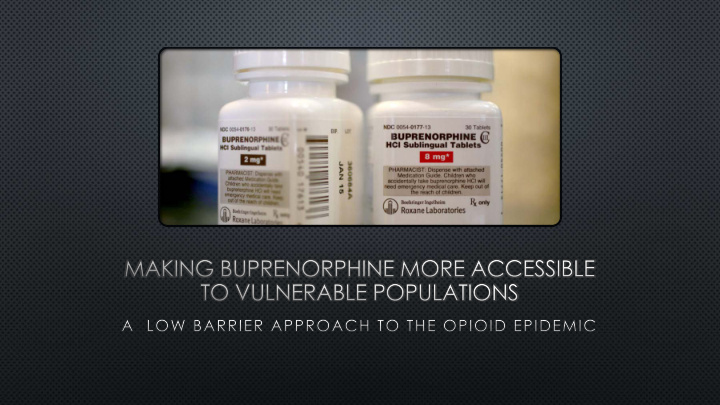



What Was it Like in Seattle/King County 5 Years Ago?
20. People’s Harm Reduction Alliance • • 1. All Home 21. Public Defender Association • King County • 2. American Civil Liberties Union 22. Public Health – Seattle & King County • • 3. Auburn Police Department 23. Puget Sound Educational Service District • Opiate • 4. City of Bellevue Fire Department 24. Recovery Community • • 5. City of Seattle Mayor’s Office 25. Renton Police Department • Taskforce 26. Seattle Children’s • • 6. Department of Community and Human Services 27. Seattle Fire Department • • 7. Department of Social and Health Services, (September 2016) Children’s Administration 28. Swedish Hospital, Pregnant and Parenting Woman • Program • 8. Downtown Emergency Services Center 29. Seattle Human Services Department • • 9. Evergreen Treatment Services 30. Seattle Police Department • • 10. Harborview Medical Center 31. Seattle Public Schools • 32. Therapeutic Health Services • • 11. Hepatitis Education Project 33. United States Attorney for Western Washington’s • • 12. Kelley-Ross Pharmacy Office 34. United States Department of Veterans Affairs, • • 13. King County Adult Drug Diversion Court Veterans Health Administration • 14. King County Emergency Medical Services 35. United States Substance Abuse and Mental Health • Services Administration (SAMHSA) • 15. King County Needle Exchange 36. University of Washington Alcohol and Drug Abuse • Institute (ADAI) • 16. King County Prosecuting Attorney’s Office 37. Washington State Department of Social and Health • • 17. King County Sheriff’s Office 18. Muckleshoot Services, Behavioral Health Administration 38. Washington State Health Care Authority Tribe • 19. Neighborcare Health
Increase in death from Heroin more present in heroin ODs, decrease in drug seizures. deaths from prescription opioids. r a c i a l c i a l a n d i c a n t s o S i g n i f r l y f o r a r t i c u l a u i t i e s , p i n e q r i c a n s a n A m e A f r i c 3-fold increase in syringe exchange compared to previous years. Source: 2016 KC Opiate Taskforce
1) Washington legislation 2) Prescribing limits Barriers to Change 4) MAT services Supply < demand 5) High barrier prescribing practices as the norm.
Recommendations Primary Prevention Treatment Expansion User Health and Overdose Prevention • Prescriber education • Treatment on Demand • Expansion and access to • Public education • Innovative Bupe narcan • Drug take back programs prescribing practices • Safe Consumption Sites • Screening for OUD ("CHELs" – Community Health Engagement Locations)
Increase Access to Treatment! Source: 2016 KC Opiate Taskforce
What Happened next?
King County Added 59 MAT sites in one year! Source: 2018 KC Opiate Taskforce Update
DESC 2016 Client Zero: A Case Study 35yo M experiencing homelessness and often in perpetual crisis. Experienced severe childhood trauma, has been using opiates since he was a young child. Has not successfully been able to access MAT services. Enrolled in a DESC mental health program. Opioid use disorder-severe stimulant (meth and cocaine) use disorder-severe cannabis use disorder-severe Bipolar I disorder PTSD 43.10 HCV (Ab+) TBI Frequent recurrent abscesses from IVDU "This stuff saved my life."
Securing Grants
2018: K ING C OUNTY MIDD (M ENTAL 2019: SAMHSA (S UBSTANCE A BUSE I LLNESS AND D RUG D EPENDENCY ) B UP P ROG M ENTAL H EALTH S ERVICE A DMINISTRATION ) SOR RAM (S TATE O PIOID R ESPONSE ) G RANT • • • • • •
Medical run program? Space Lack of precedent Capacity Workflow Provider time
OPIOID TREATMENT NETWORK
• Started in April 2019 • SAMSHA funded: Total grant $450,000 for 2 years • Team members: Nurse Supervisor, 2 RNs, Nurse DESC's O DE Opio ioid id Practitioner (part-time), Care Navigator, Substance Use Disorder Professional, Data Treatment Tr Collection Specialist Ne Network rk • 80+ Clients currently: Funding dependent on adding at least 18 new clients per month Program Pr • Clients can be anywhere in Seattle. Serve people living in DESC supportive housing, independent housing, street, shelters, tent encampments.
Program Pr St Struc uctur ure Induction Initial intake Prescriber intake Prescription Ongoing Follow Up Induction Prescription and Care
Wha What Makes s us us Low w Ba Barri rrier? r? This Photo by Unknown author is licensed under CC BY-SA-NC.
Avoid lapses in medication Flexible appointments Low Barrier Outreach Strategies Easy communication Harm reduction approach
No firm rule on when medication will be held. Do not hold prescription for first Based on individual client, history missed follow-up of engagement, etc. Avoid id L Lap apses in T in Treatment Try different strategies to increase follow up: Care conferences and outreach, picking up case consulting medication in clinic
Intakes and follow-ups can be either scheduled or walk-in At least one OTN team member Flexible Appointments available for walk-in intakes at all times. Nurse practitioner is available for walk-ins at least 3 hours per day
Outreach to anywhere a client lives including tent encampments, shelters, street Will outreach anyone who wants to be on Suboxone but is unable or unwilling to come to clinic Ou Outreach Everyone on team able to outreach including nurse practitioner 1/3 of current clients require outreach for all follow-ups
Clients can reach team members by text or call on work provided cell phones during working hours Easy Communication Unfortunately, only about ¼ of clients have phones
Focus on reduction in use, improvement in quality of life over abstinence Monthly urine screening per HCA Harm guidelines Reduction Results do not effect treatment, unless Approach negative for buprenorphine Bup negative does not stop treatment, but may change care plan
• Lack of racial diversity in clientele • Staffing and capacity • Difficulty moving people onto longer Ongoing term maintenance scripts • Stigma and suspicion around opioid Challenges replacement medication (even among DESC staff) • High-barrier to methadone access • Medication monitoring
Recommend
More recommend